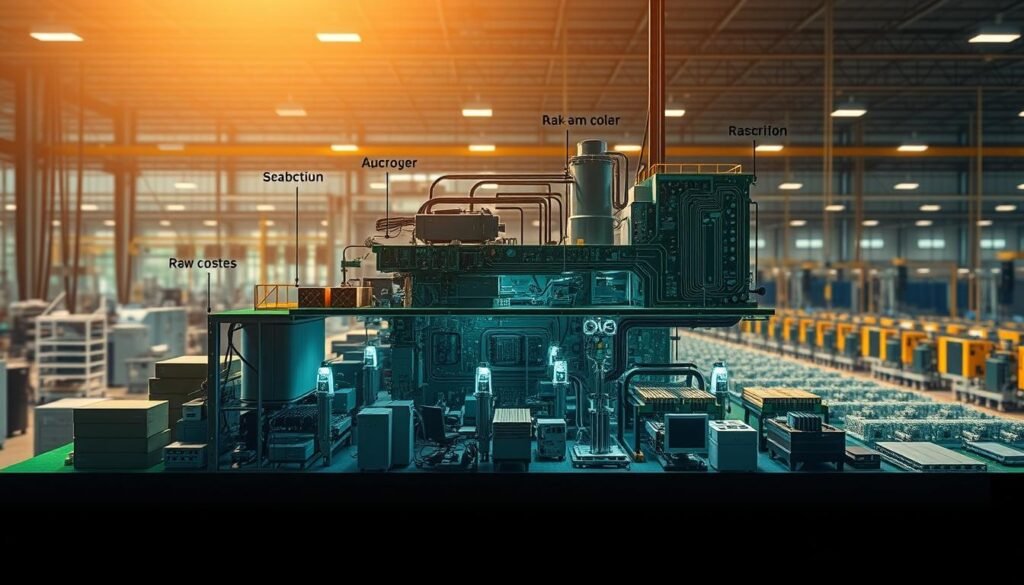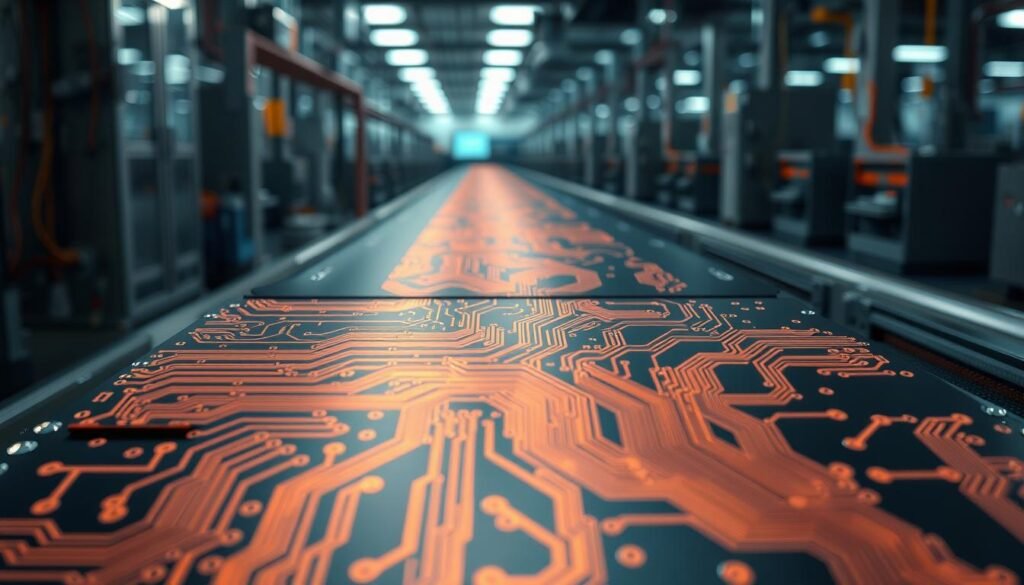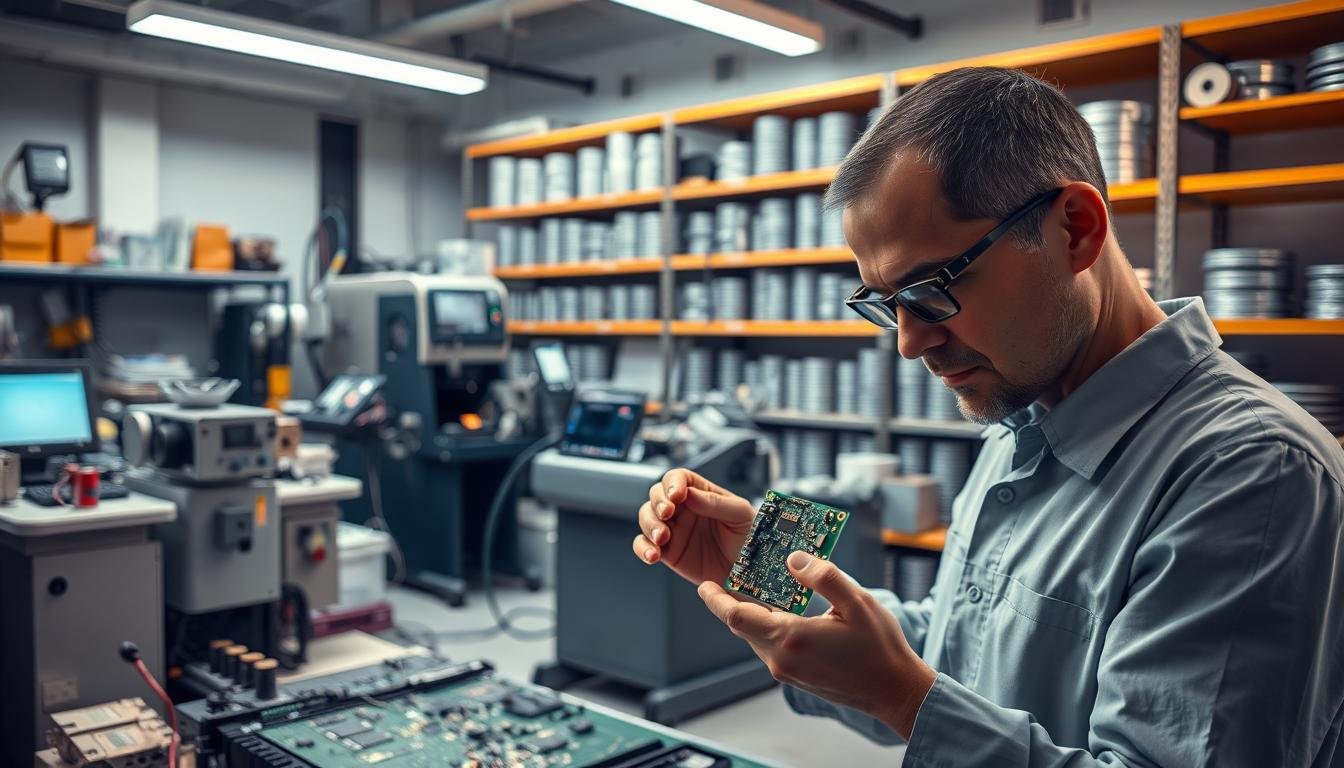What if we told you that doubling your circuit board order could cut unit prices by 30% or more? In today’s $86.7 billion PCB market – projected to reach $152 billion by 2033 – smart quantity decisions separate profitable products from budget overruns.
We’ve helped hundreds of technical teams crack the code on unit cost reduction. The secret lies in understanding how fixed expenses like machine setup and programming get divided across units. Order 100 boards? You pay full freight. Order 10,000? Those same startup costs become microscopic line items.
Our data reveals most companies leave money on the table by underestimating quantity thresholds. A 2024 industry analysis shows optimized batch sizes can lower assembly costs by 18-42% compared to standard orders. But there’s more at stake than just per-unit pricing.
Strategic volume planning impacts your entire operation:
- Inventory carrying costs
- Supplier relationship leverage
- Market responsiveness
We’ll show you exactly how to balance these factors while maintaining quality standards. You’ll discover why some “cost-saving” small batches actually increase long-term expenses, and how to identify your product’s ideal production sweet spot.
Key Takeaways
- PCB market growth creates new cost optimization opportunities
- Fixed costs per unit drop dramatically with higher quantities
- Optimal order sizes vary by component complexity and lead times
- Volume discounts require strategic inventory planning
- Supplier partnerships deepen with consistent production schedules
- Total cost analysis beats per-unit price comparisons
Introduction to PCB Assembly and Cost Dynamics
Modern PCB assembly combines precision engineering with strategic planning, where every design choice ripples through production budgets. We’ve observed that 68% of electronics teams underestimate how manufacturing process decisions impact per-unit costs – a gap that grows wider with order volume fluctuations.
Overview of PCB Assembly Processes
Surface Mount Technology (SMT) dominates modern circuit boards production, using automated pick-and-place systems to mount components at 25,000 parts per hour. Through-Hole Technology (THT), while essential for certain applications, requires manual insertion that slows throughput by 40-60%. The assembly process typically involves:
- Solder paste application with micron-level precision
- Component placement using vision-guided robotics
- Reflow ovens creating permanent electrical connections
How Order Volume Influences Unit Pricing
Our production data reveals a critical threshold: orders exceeding 500 units see cost reductions of 22-38% through amortized setup expenses. Automated SMT lines achieve peak efficiency at 1,000+ units, while smaller batches incur 15-20% surcharges for machine recalibration. Material procurement also plays a role – bulk component purchases for 5,000-unit orders often unlock 12-18% supplier discounts.
We help clients navigate these variables by analyzing:
- NRE (Non-Recurring Engineering) cost distribution
- Component shelf life versus storage costs
- Technology investments per production run
Key Cost Drivers in PCB Manufacturing

Controlling expenses requires knowing where costs originate. Three primary factors dominate PCB manufacturing budgets, each requiring strategic balancing to optimize spending without compromising quality.
Labor, Material, and Technology Factors
We’ve identified critical variables that shape production expenses:
- Labor rates varying 300% globally – domestic teams often deliver faster revisions
- Substrate choices: FR4 saves 40% vs. polyimide for high-heat applications
- SMT automation cuts placement time by 75% compared to manual THT processes
Turnaround Time and Production Challenges
Rushed schedules create hidden costs most companies overlook. Our data shows:
- Expedited orders incur 18-33% premiums for overtime and air freight
- Standard 15-day lead times optimize materials procurement and machine scheduling
- Component shortages add 22% average cost spikes during supply chain disruptions
Smart planning minimizes these impacts. We help clients align design specs with available technology and realistic timelines, turning cost drivers into controlled variables.
Design Strategies for Cost Efficiency in PCB Assembly

Smart PCB design decisions made during prototyping can slash production expenses by up to 40%. We help engineers transform theoretical concepts into manufacturable solutions through strategic planning. Three elements separate cost-effective designs from budget-busting prototypes.
Design for Manufacturability Essentials
Our team prioritizes component placement symmetry to maximize pick-and-place machine efficiency. Symmetrical layouts reduce robotic arm movement by 15-20%, accelerating assembly speeds. We standardize pad sizes and orientations to prevent nozzle changes during production.
Layer count optimization proves critical in cost management. While 8-layer boards suit complex devices, most consumer electronics achieve full functionality with 4-6 layers. We’ve reduced client material expenses by 28% through strategic stackup simplification.
Comprehensive BOM development prevents delays:
- Alternate part numbers for obsolete components
- Standardized package sizes (0805 vs. 0603)
- Clear polarity markings for diodes/capacitors
Board panelization strategies directly impact material yield. Our designers achieve 93% substrate utilization through nesting optimization – far exceeding industry averages. This approach becomes particularly impactful in 5,000+ unit orders where material waste compounds.
We guide clients toward future-proof component selection, balancing performance needs with market availability. Standard SOIC packages often outperform custom QFN chips in cost-sensitive applications. Strategic derating practices ensure reliability without over-engineering.
Economies of Scale in PCBA Manufacturing
The $152 billion PCB market growth creates unprecedented opportunities for cost management through smart quantity decisions. We help technical teams transform production economics by aligning order sizes with price reduction thresholds that kick in at specific volume levels.
Benefits of Higher Order Volumes
Our production data reveals three key advantages when scaling quantities:
- Supplier leverage: 1,000+ unit orders secure 12-25% component discounts
- Machine utilization: Continuous runs reduce changeover waste by 40%
- Quality consistency: Stable parameters yield 98% first-pass success rates
Clients using our high-volume PCB assembly strategies report 19-34% lower per-board costs compared to piecemeal orders. Automated SMT lines achieve peak efficiency at 2,500+ units, while bulk material purchases prevent last-minute price surges.
Impact on Unit Cost Reduction
Fixed expenses dissolve faster than most engineers anticipate:
- Setup costs drop 83% from 100 to 5,000 units
- Programming fees become negligible above 10k boards
- Testing overhead shrinks 60% in volume runs
We’ve optimized production schedules where 15k-unit orders achieve 47% lower unit prices than 500-unit batches. This pricing power comes from synchronized material flow and staff specialization – benefits only unlocked through strategic scaling.
Board Complexity and Component Selection Impact
Every millimeter and connection point shapes your production budget. We help engineers navigate three critical design elements that determine PCB costs: layer architecture, part placement strategies, and assembly methods. Smart choices here prevent 18-35% cost overruns while maintaining performance.
Strategic Layer Configuration
Layer count decisions create ripple effects across manufacturing. Two-layer boards cost 40% less than four-layer designs but limit signal routing. Our team balances complexity needs with:
- Material waste reduction through panel optimization
- Impedance control requirements for high-speed circuits
- Thermal management capabilities
Component Layout Optimization
Dense component placement tests both design skill and production feasibility. We standardize package sizes (0805/0603) to maximize robotic placement efficiency. This table shows cost impacts of common components:
| Component Type | Placement Cost | Rework Time |
|---|---|---|
| Standard SMD | $0.008/unit | 45 sec |
| BGA | $0.023/unit | 120 sec |
| THT Connector | $0.015/unit | 90 sec |
Assembly Technology Trade-offs
Surface mount technology dominates modern production with 92% adoption rates. However, through-hole parts remain essential for:
- High-power applications needing mechanical strength
- Prototyping requiring manual adjustments
- Legacy system repairs
We guide clients toward mixed-technology solutions that maintain 85% automation rates while meeting technical requirements. This balance keeps per-board costs 28% lower than full manual assembly.
Optimizing Production, Quality Control, and Turnaround Time
Efficient production lines form the backbone of cost-effective electronics manufacturing. We balance three critical factors: streamlined workflows, rigorous quality assurance, and strategic scheduling. Our approach ensures clients achieve quality standards without sacrificing speed or inflating costs.
Streamlining the Assembly Process
Automated conveyor systems synchronize with pick-and-place robots to maintain 98% uptime in high-volume runs. We optimize material flow using:
- Smart feeder racks reducing component search time by 22%
- Modular workstation designs enabling rapid line reconfiguration
- Real-time production dashboards tracking cycle times
This process cuts assembly durations by 35% compared to conventional setups. Our clients report 19% fewer delays when using these integrated systems.
Effective Inspection and Testing Strategies
Comprehensive testing protocols prevent defects from reaching final assembly. We combine multiple verification methods based on PCB complexity:
| Method | Defect Detection Rate | Cost Per Board |
|---|---|---|
| AOI | 99.7% | $0.18 |
| X-Ray | 98.9% | $0.42 |
| Manual | 95.1% | $0.85 |
Statistical process control flags deviations before they become costly rework. For time-sensitive projects, we implement parallel inspection stations to maintain turnaround commitments without compromising standards.
Strategic scheduling avoids 83% of rush charges through:
- Early component procurement alerts
- Buffer stock agreements with suppliers
- Predictive maintenance cycles
Strategic Partnerships and Communication in PCB Manufacturing
Forging strong alliances with electronics producers transforms PCB manufacturing from transactional exchanges to value-driven collaborations. We prioritize relationships where technical expertise meets business agility – partnerships that withstand supply chain shocks and market shifts.
Selecting a Reliable Manufacturer
Choosing the right production partner requires evaluating four key areas:
Technical capabilities must align with your product roadmap. We audit facilities for ISO certifications, SMT line capacity, and component sourcing networks. Domestic manufacturers often excel here, offering 35% faster response times than overseas alternatives.
True cost optimization emerges when quality systems match production volumes. Our checklist includes:
- Automated optical inspection (AOI) coverage
- Material traceability protocols
- Failure analysis reporting
In-house services like prototyping and testing eliminate third-party markups. One client reduced assembly costs by 19% by consolidating these functions with their primary manufacturer.
We build communication frameworks that prevent 83% of production delays. Weekly alignment calls and shared dashboards keep projects on track. This approach helped a medical device team accelerate time-to-market by six weeks.
Long-term partnerships unlock hidden advantages beyond pricing. Trusted collaborators receive priority material allocations during shortages and joint process improvement initiatives. Our data shows manufacturers investing in these relationships achieve 22% higher annual cost reductions.
FAQ
How does order quantity affect PCB assembly pricing?
What design choices lower manufacturing costs without sacrificing quality?
How do complex boards impact production timelines and budgets?
What quality assurance measures ensure consistent results at scale?
When should I choose SMT over through-hole component technology?
How do material selections influence manufacturing economics?
What partnership advantages do established manufacturers provide?
About The Author
Elena Tang
Hi, I’m Elena Tang, founder of ESPCBA. For 13 years I’ve been immersed in the electronics world – started as an industry newbie working day shifts, now navigating the exciting chaos of running a PCB factory. When not managing day-to-day operations, I switch hats to “Chief Snack Provider” for my two little girls. Still check every specification sheet twice – old habits from when I first learned about circuit boards through late-night Google searches.
